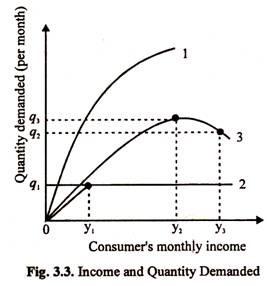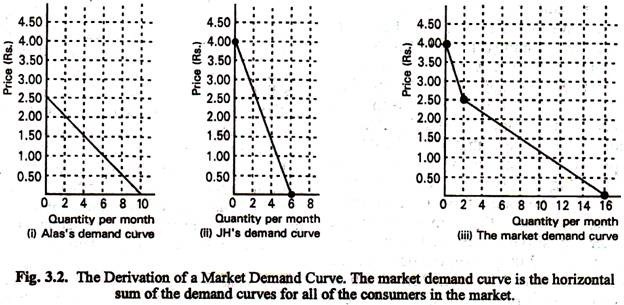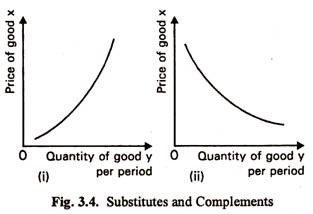Read this article to learn about the factors affecting demand and interrelationships of demand.
Factors Affecting Demand:
1. Income:
The effect of income on demand depends on the nature of the commodity under consideration.
For the sake of analysis goods are divided into the following three categories:
(a) Normal Goods:
ADVERTISEMENTS:
Most of the commodities that we buy are called normal (superior) goods. In general, a consumer buys more of a good when its price falls and less of it when its price rises. The commodities that obey this rule are called normal goods. Two exceptions may be noted in this context.
(b) Goods Subject to Satiation:
In case of some commodities like salt or writing ink, we observe that the quantity demanded remains unchanged as soon as the consumer’s income reaches a critical level. At this level of income the demand for such commodities is completely satisfied. If, for instance, a consumer’s income rises from Rs. 2,500 to Rs. 2,700, his monthly demand for salt is unlikely to be affected. If, however, his income falls from Rs. 2,500 to Rs. 1,000 per month, the demand for salt may fall.
(c) Inferior Goods:
ADVERTISEMENTS:
An inferior good is one the quantity demanded of which falls when income rises and vice versa. Old cars, black and white TV sets, ordinary bread, second-hand tyres are also examples of such goods. As income rises above a particular level a consumer prefers to replace a black and white TV set by a coloured one, or one old by a new one or ordinary bread by white bread.
The inferior goods are those which are considered as cheap but inferior substitutes for other commodities. It may be noted that inferiority is relative to income. In fact, the same commodity may be a superior good and an inferior good at two different levels of income.
In Fig. 3.3 we show the relationship between income and demand for a good assuming that all other variables (except income) remain constant. Now we measure income on the horizontal axis and the quantity demanded of a commodity on the vertical axis. Curve 1 shows the case of a normal good. In case of such a good quantity demanded and income are positively related.
On the other hand, Curve 3 shows the case of an inferior good. In this case quantity demanded and income are negatively related. In this case, the commodity is an inferior good after a certain level of income (i.e. Y2) is reached. So long as income is less than Y2 the commodity is a normal good. If income increases from Y2 to Y3, quantity demanded falls from q3 to q2. So it is clear that a commodity cannot be an inferior good at all levels of income.
ADVERTISEMENTS:
Curve 2 illustrates the case in which the commodity is a normal good up to income level y1. If income increases further demand does not increase or decrease. The same quantity (q1) is demanded at all levels of income. Such a good may be a neutral good. Such a neutral good is one whose demand does not respond to income changes.
2. Prices of Other (Related) Goods:
The consumer spends his limited income on different commodities. Each commodity has a price. When the price of a particular commodity changes the relative prices of other goods are affected. Thus a change in the price of one good affects the demand for another good due to a change in their relative prices.
If the price of fish falls and the price of meat remains constant people would normally buy more fish and less meat. It is because fish is relatively cheap and meat is relatively expensive (although nothing happens to the absolute price of meat). Thus the demand for a commodity is affected by the market prices of other commodities.
These commodities are usually divided into three categories:
(a) Substitutes,
(b) Complements and
(c) Unrelated good.
(a) Substitutes:
ADVERTISEMENTS:
A fall in the price of one good (say coffee) may lead to a fall in the quantity of another good (say tea). The converse is also true. If this happens the two goods are said to be substitutes of each other, as is shown in Fig. 3.2 (i). In this case as the price of good x falls the quantity demanded of good y falls. There are various examples of such substitutes such as fish and meat, butter and ghee, bus rides and taxi rides, liquid milk and condensed milk, cinema tickets and theatre tickets.
(b) Complements:
If the price of a commodity (say petrol) falls, the quantity demanded of another commodity (say motor cars) may increase. If this happens the two commodities will be treated as complements. If the demand for petrol increases the demand for cars will also increase and vice versa. In fact, if the demand for a good increases due to a fall in price the demand for other commodities (that are complements to it) will also increase automatically. The point is illustrated in part (ii) of Fig. 3.4(ii). In Fig. 3.4(ii), if the price of X falls, the quantity demanded of y increases.
ADVERTISEMENTS:
In general, goods that complements are consumed together. Examples are tennis balls and tennis rackets, video recorders and video cassettes, cameras and films, shoes and socks. These are examples of joint demand in the sense that they are jointly demanded.
If more are derived by the consumer, the more of the other will also be wanted. If the price of video recorders changes there will be an effect not only on the quantity demanded of video recorders, but also on the demand for video cassettes. Thus, a fall in the price of the recorders will lead to an increase in the demand for cassettes.
3. Expectations:
If income and price changes occur suddenly people cannot react before the change has occurred. But sometimes people can foresee the changes, in which case they can react to the expectation that price or income changes will occur in future.
ADVERTISEMENTS:
If the price of a commodity is expected to rise in future people will buy more of it than what they normally require. If people expect that their incomes’ will rise in near future they can borrow money now and spend it on consumption goods. They hope to be able to repay the loan when their income actually rises in the future.
4. Other Factors:
Four other factors may and often do affect the demand for a good.
These are called non- economic factors and are the following:
(a) Demographic and Sociological Factors:
Such factors include age, sex, marital status (i.e., whether an individual is married or not), health, the level of education, social status, place of residence (whether urban or rural) as also moral and religious values. The last set of factors may be induced by family, peer group or political allegiance.
(b) Physiological Factors:
ADVERTISEMENTS:
Here we include all the factors, inherited or acquired, that affect the personality of an individual and his taste and preference. We also include such factors as fads and fashions.
(c) Random Variables:
Such factors include the weather, earthquakes, diseases, etc. These also include such un-systematic events as strikes, revolution, war, riots, etc.
(d) Government Action:
The demand for a number of commodities may be affected by government action. Examples are rules compelling the wearing of helmets by scooterists, statutory warning on cigarette smoking, banning the sales of non-veg. food in certain parts of the country (such as Hardwar), regulations on the emissions from car exhausts, etc. The permission given to people by the Central and State governments to the ballpoint pens in writing answer-scripts in examinations, in signing cheques and various legal documents has raised the market demand for ball-point pens and a corresponding fall in the demand for fountain pens.
Interrelationships of Demand:
Changes which take place in the demand for the first will then affect in some way the demand for the second.
ADVERTISEMENTS:
We usually find four such inter-relation- ships:
1. Joint Demand:
Joint demand exists in case of complimentary goods such as cars and petrol or shoes and socks. Thus a fall in the price of petrol will lead to an increase in the demand for cars.
2. Derived (Indirect) Demand:
The demand for a factor of production is derived from the demand for the commodity in the product of which the factor is used. Thus the demand for bricks is derived from the demand for houses and the demand for cotton is derived from the demand for clothes. If the price of cotton shirts increases so that the quantity demand of such shirts falls, this will reduce the demand for cotton.
Derived demand differs from joint demand in that one product is actually used to produce the other.
3. Competitive Demand:
This refers to a situation where commodities are substitutes for each other, e.g., mutton and lamb, rail transport and bus transport. If the price of rail transport increases, fewer people will use trains and most will travel by bus. So the demand for bus transport will increase.
4. Composite Demand:
When one product is demanded for a number of different uses, e.g., wool for use in clothes, carpets etc., steel for using the manufacture of cars, machinery, etc., we speak of ‘composite demand’. An increase in the demand for the product in one use may affect the supplies available for the other uses and therefore may affect the demand and price in those markets.


